#botfly adult
Explore tagged Tumblr posts
Text

Forced Intimacy
#omens art#digital art#digital illustration#bugs#botfly adult#botfly larvae#trypophobia#Putting that there just in case
12 notes
·
View notes
Text

Another batch of Helio-verse demons! Envy demons are parasitic, at least partially insectoid creatures, full of holes they can never quite fill. Gabe gave me the option to make a demon of my own as part of the batch, so I did! From left to right: Shroomoth, Desmodontineid, and my own addition, Nyiasis.
#commission#flat color#adventures of helio#demons#tw bugs#tw body horror#fun fact: adults of some botfly species mimic bumblebees >:3c
4 notes
·
View notes
Text
Anyway while we're on the subject of public misconception towards living things (which is completely understandable because have you SEEN living things? There's like dozens of them!) here's a fresh rundown of some common mistakes about bugs!
Arachnids aren't just spiders! They're also scorpions, mites, ticks and some real weirdos out there
Insects with wings are always finished growing! Wings are the last new thing they ever develop! There can never be a "baby bee" that's just a smaller bee flying around.
That said, not all insects have larvae! Many older insect groups do look like little versions of adults....but the wings rule still applies.
Insects do have brains! Lobes and everything!
Only the Hymenoptera (bees, ants and wasps) have stingers like that.
Not all bees and wasps live in colonies with queens
The only non-hymenoptera with queens are termites, which is convergent evolution, because termites are a type of cockroach!
There are still other insects with colonial lifestyles to various degrees which can include special reproductive castes, just not the whole "queen" setup.
Even ants still deviate from that; there are multi-queen ant species, some species where the whole colony is just females who clone themselves and other outliers
There is no "hive mind;" social insects coordinate no differently from schools of fish, flocks of birds, or for that matter crowds of humans! They're just following the same signals together and communicating to each other!
Not all mosquito species carry disease, and not all of them bite people
Mosquitoes ARE ecologically very important and nobody in science ever actually said otherwise
The bite of a black widow is so rarely deadly that the United States doesn't bother stocking antivenin despite hundreds of reported bites per year. It just feels really really bad and they give you painkillers.
Recluse venom does damage skin, but only in the tiny area surrounding the bite. More serious cases are due to this dead skin inviting bacterial infection, and in fact our hospitals don't carry recluse antivenin either; they just prescribe powerful antibiotics, which has been fully effective at treating confirmed bites.
Bed bugs are real actual specific insects
"Cooties" basically are, too; it's old slang for lice
Crane flies aren't "mosquito hawks;" they actually don't eat at all!
Hobo spiders aren't really found to have a dangerous bite, leaving only widows and recluses as North America's "medically significant" spiders
Domestic honeybees actually kill far more people than hornets, including everywhere the giant "murder" hornet naturally occurs.
Wasps are only "less efficient" pollinators in that less pollen sticks to them per wasp. They are still absolutely critical pollinators and many flowers are pollinated by wasps exclusively.
Flies are also as important or more important to pollination than bees.
For "per insect" pollination efficiency it's now believed that moths also beat bees
Honeybees are non-native to most of the world and not great for the local ecosystem, they're just essential to us and our food industry
Getting a botfly is unpleasant and can become painful, but they aren't actually dangerous and they don't eat your flesh; they essentially push the flesh out of the way to create a chamber and they feed on fluids your immune system keeps making in response to the intrusion. They also keep this chamber free of bacterial infection because that would harm them too!
Botflies also exist in most parts of the world, but only one species specializes partially in humans (and primates in general, but can make do with a few other hosts)
"Kissing bugs" are a group of a couple unusual species of assassin bug. Only the kissing bugs evolved to feed on blood; other assassin bugs just eat other insects.
6K notes
·
View notes
Text
spotted an absolute delight on my walk today, this is only the second time I've ever seen an adult botfly and the first time I was able to photograph one! I think this one is a rodent botfly in genus Cuterebra.
this was an insect I've been so excited to finally see in person!
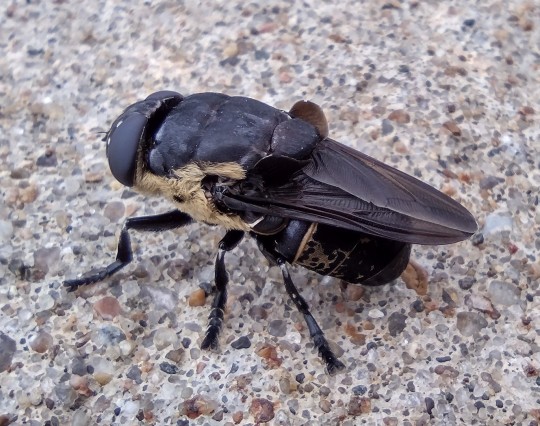
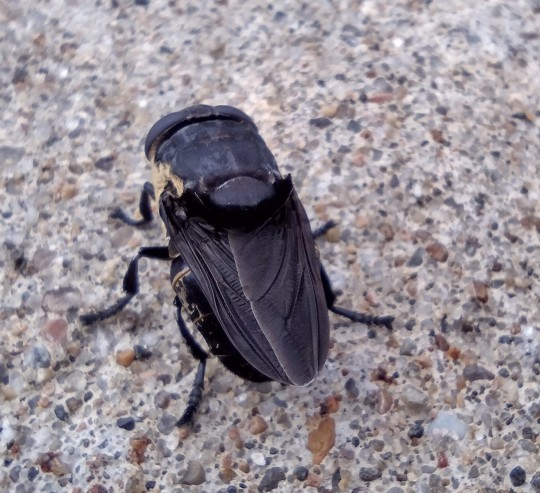

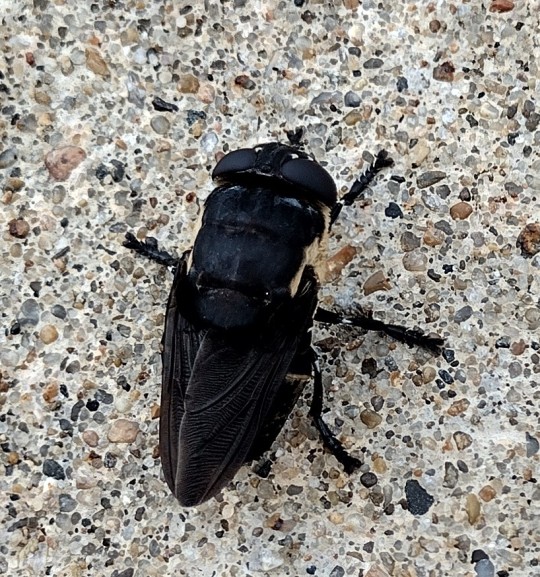
#diptera#botfly#insect#Cuterebra#if you are mean or hateful about him I Will just block you I dont care
75 notes
·
View notes
Text
I wonder how many people have felt so betrayed upon seeing the infamous botfly in its adult stage..
8 notes
·
View notes
Text
TW: Body deformation, self surgery, vermins
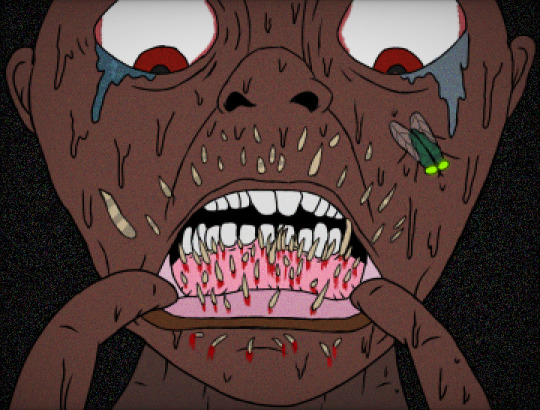
ANM №: ANM-590
Identification: Parasitic Gingival Larvae
Danger Level: Kali 🟠 | Contained ⭕️
Responsible Researcher: None
Anomaly Type: Parasitic, insectoid
Confinement: All instances of ANM-590 larvae are to be contained in a standard containment chamber at Department-05, equipped with a positive-pressure ventilation system to prevent the spread of eggs or larvae. The chamber is to be regularly monitored by Level 2 personnel, and entry is restricted to medical staff or researchers with Level 3 clearance or higher.
Any personnel exposed to ANM-590 are to undergo immediate decontamination and report to D-05's medical wing for examination. If signs of infestation are found, the affected individual is to be quarantined and treated with oral surgical removal procedures followed by a course of antiparasitic medication.
All captured instances of ANM-590 adult specimens are to be kept in an airtight containment chamber and destroyed by incineration. Under no circumstances are live adult specimens to be allowed to escape or reproduce outside of containment. Field agents are tasked with monitoring dental clinics, hospitals, and any locations with reported cases of unexplained gingival inflammation or infestations of unknown parasites.
Description: ANM-590 refers to an anomalous species of parasitic botfly (Diptera: Oestridae) that exclusively targets the gingival (gum) tissue of human hosts. Adult ANM-590 specimens are visually similar to non-anomalous botflies (Dermatobia hominis) but exhibit several key deviations. Most notably, ANM-590 demonstrates a unique parasitic reproductive cycle, wherein its larvae (designated ANM-590-1) develop within the soft tissues of the human oral cavity, specifically targeting the gums.
Life Cycle and Reproduction:
1. Adult Stage:
ANM-590 adults resemble a typical botfly in appearance, with iridescent green and black coloration and an approximate body length of 12-14 mm. Unlike common botflies, ANM-590 adults are active primarily during nighttime, seeking out human hosts through a combination of chemical signals, including pheromones produced by the human body and trace amounts of blood from gingival irritation or damage, or from bacteria likely to appear if the individual does not brush their teeth.
During oviposition, an adult ANM-590 will release a specialized neurotoxin via its ovipositor to numb the host's gums. Once the host is anesthetized, the fly deposits eggs directly beneath the gum line. This process is generally painless and often goes unnoticed by the victim.
2. Egg and Larval Stage (AMM-590-1):
After approximately 48 to 72 hours, ANM-590 eggs hatch into larvae (ANM-590-1). The larvae possess highly specialized mandibles, which allow them to burrow into the soft tissue of the gums. As they develop, ANM-590-1 larvae feed on both blood and gingival tissue, causing localized swelling, bleeding, and irritation. This stage lasts 10 to 14 days, during which time the larvae grow to a size of 8-10 mm in length.
Hosts report symptoms similar to periodontal disease, including:
Persistent itching or tingling sensation in the gums
Swollen or bleeding gums, especially when brushing teeth or eating
Unexplained tooth sensitivity
In rare cases, sensations of "crawling" or movement within the gums
Once mature, the larvae migrate toward the surface of the gums, often concentrating around the base of the teeth. At this stage, they secrete an enzyme that dissolves part of the gum tissue, creating small abscesses or lesions that allow the larvae to escape. In some cases, larvae can be manually expelled by squeezing the affected area, though this can lead to secondary infections.
3. Pupal Stage and Emergence:
Once the larvae emerge, they fall to the ground and burrow into the nearest soft substrate, where they enter the pupal stage. After approximately 1-2 weeks, adult ANM-590 flies emerge and the cycle begins anew.
Anomalous Properties:
ANM-590-1 larvae exhibit rapid tissue regeneration and healing properties in their host, preventing severe damage to the gums despite extensive feeding. This is believed to be a survival adaptation that ensures the host remains functional until the larvae reach maturity. The host's immune system is also suppressed, minimizing inflammatory responses, which further allows the larvae to go unnoticed.
While ANM-590 infestations do not typically result in fatalities, they can cause long-term dental damage if untreated. In severe cases, ANM-590 larvae may become dislodged and enter the bloodstream, causing embolisms or systemic infections, although this is exceedingly rare.
Psychological effects have been noted in several cases. Infested individuals frequently report anxiety, insomnia, and obsessive-compulsive behaviors related to oral hygiene, often excessively brushing or flossing their teeth in an attempt to alleviate the sensation of crawling or itching.
Discovery:
ANM-590 was first identified in 20██ after a series of reports surfaced from rural villages in Belford Roxo, Brazil, where several individuals had been admitted to local hospitals for extreme gingival irritation. Initial reports were dismissed as cases of severe periodontal disease or fungal infections, but further investigation by Institute agents revealed that the symptoms were caused by an unknown parasitic entity.
Subsequent containment efforts led to the identification of several breeding sites in tropical forested regions, where adult ANM-590 specimens were captured for study. Due to the widespread nature of non-anomalous botfly species, it is believed that ANM-590 may have existed undetected for decades before being formally classified by the MOTHRA.
Addendum 590-A:
Interview Log 590-04:
Interview with Dr. Moron, a Institute dentist and researcher who was exposed to ANM-590 while examining a patient.
Interviewer: Dr. █████
Date: 20██
Dr. Moron: "The itching. It was unbearable. At first, I thought it was just dry gums, maybe an allergic reaction to something. But then… I felt it, like something was moving under the surface. I had this irrational urge to dig into my gums, to get whatever was inside me out."
Interviewer: "You performed a self-extraction, correct?"
Dr. Moron: "Yes. I used a pair of sterilized dental tweezers and started probing around one of the swollen areas. That's when I saw them. Tiny, wriggling white larvae, right at the base of my molar. I can still feel it sometimes, even though they’re all gone. It’s like they left something behind."
Interviewer: "Did you experience any psychological effects?"
Dr. Moron: "Every night I dream about it. The sensation of them moving, feeding, growing. I keep imagining they’re still in there, just deeper. Hiding."
Addendum 590-B:
Following the interview, Dr. Moron was placed on temporary medical leave and has been referred to psychological counseling due to ongoing symptoms of parasitosis and persistent gum irritation. No further ANM-590 larvae were found during follow-up examinations.
Note: Personnel exposed to ANM-590 should be monitored closely for similar psychological aftereffects, even after physical decontamination and removal. Further research into the long-term effects of ANM-590 infestation is ongoing.
Addendum 590-C:
Due to increased reports of ANM-590 infestations in urban areas, containment teams have been deployed to dental clinics and hospitals in high-risk regions. Task Force "Mouthwashers" has been created to respond to outbreaks and prevent ANM-590 from spreading into densely populated areas.
End of File
6 notes
·
View notes
Text

I wondered what adult botflies looked like… no one told me they were kind of cute!!!
I guess the price to pay is a horrific childhood…
39 notes
·
View notes
Text
"
The human botfly, Dermatobia hominis (Greek δέρμα, skin + βίος, life, and Latin hominis, of a human), is a species of botfly whose larvae parasitise humans (in addition to a wide range of other animals, including other primates[1]). It is also known as the torsalo or American warble fly,[1] though the warble fly is in the genus Hypoderma and not Dermatobia, and is a parasite on cattle and deer instead of humans.
Dermatobia fly eggs have been shown to be vectored by over 40 species of mosquitoes and muscoid flies, as well as one species of tick;[2] the female captures the mosquito and attaches its eggs to its body, then releases it. Either the eggs hatch while the mosquito is feeding and the larvae use the mosquito bite area as the entry point, or the eggs simply drop off the muscoid fly when it lands on the skin. The larvae develop inside the subcutaneous layers, and after about eight weeks, they drop out to pupate for at least a week, typically in the soil. The adults are large flies lacking mouthparts (as is true of other oestrid flies).
This species is native to the Americas from southeastern Mexico (beginning in central Veracruz) to northern Argentina, Chile, and Uruguay,[1] though it is not abundant enough (nor harmful enough) to ever attain true pest status. Normally the greatest risk they pose to humans is increasing the chances of infection. Since the fly larvae can survive the entire eight-week development only if the wound does not become infected, patients rarely experience infections unless they kill the larva without removing it completely.
"
3 notes
·
View notes
Text
That's Freek Vonk! He's from my city! He's like the Dutch Steve Irwin - but even more hyped up (and before English speaking tumblr goes to make jokes about "freak funk" or whatever - his first name is pronounced like "frake" -it rhymes with snake!- and Vonk with a short o like in hold).
The outfit is just what he was wearing at the time - because why bother changing when there's a huge ass snake to be found? He's just Like That. (he said he hesitated about 0,01 seconds before jumping into the water for a swim with this beast) Absolutely NOBODY in the Netherlands is surprised at this. If you google any random (dangerous) animal, chances are you'll find a picture of him holding it.
The guy was bit by a shark once while filming his TV show and he was like "no, no, we have to get this on camera, it's important." and the entire country was glued to their TV when it aired because everyone had seen the pictures of the state his arm was in after the bite - and the scar after it healed. And he was stung/bitten by a human botfly last year, which then laid eggs in his leg... that he kept in there until they 'hatched' and the larvae crawled out on their own and turned into an adult fly. I believe they're on display in Naturalis (museum) in Leiden now.
And he's absolutely pissing himself on insta (and FB) now over the reactions


check out his insta, it's full of weird and wonderful posts like this - and today (Feb 24th) is his birthday!
I just saw that on his profile, I didn't just know that off the top of my head.
hi do y'all mind if i misuse this blog entirely for a second. idk why i'm asking i don't actually care they found a new snake it's a New Snake we didn't know about this snake before!!!!
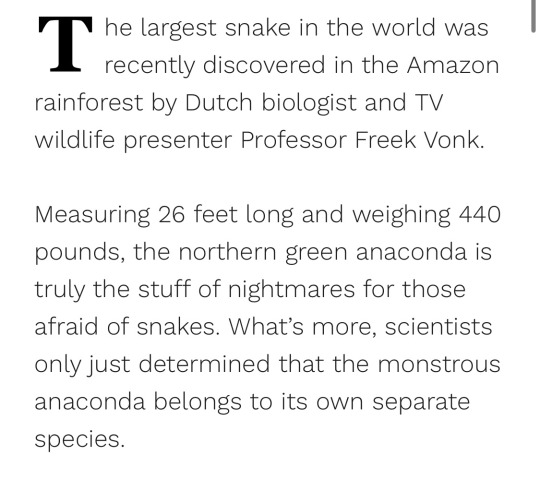
#Sorry for the Dutch hijacking#But do you know how rare it is#To see a Dutch person in the news/media outside of the Netherlands??
90K notes
·
View notes
Text
this is the deer botfly, Cephenemyia stimulator:

adorable! very pettable.
Cephenymia are a genus of botflies, and the reason they resemble bumblebees so much is because they mimic them! but there's also grayer individuals.
the genus name Cephenemyia comes from the Greek 'kēphēn', "drone bee", and 'myia', "fly". many of the species within the genus are found in North America, and some also in Europe, including the above C. stimulator.
the earliest mentions of the botfly are from 384 bce, written by Aristotle himself. fast forward to 1927, when the entomologist Charles Townsend published estimates of the Cephenemyia being the fastest of all flying insects, travelling faster than the speed of sound (1236 km/h).
these estimates were claimed as truth, until 1938, when the physicist Irving Langmuir debunked them. he made several points proving Townsend's claims to be not only inaccurate but physically impossible, among them the fact that a fly travelling faster than the speed of sound would produce an audible sonic boom, and such a fly would leave a wound close to that left by a gunshot on the human body. he estimated the true speed of a deer botfly to be around 40 km/h.
what do these silly little guys—i'm referring to the flies—have do with deer? well, when the eggs hatch in the uterus of a pregnant female botfly, she finds a deer, and, while hovering near the target's head, ejects the larvae into the deer's nostril. they travel to the host's throat, where they feed on the tissue and can grow to be over 3 cm in length—there may be up to twenty of them, according to Aristotle.
they pupate in soil after being ejected by the deer. as adults, they do not have a functional mouth and thus cannot eat. they must, then, find a mating partner quickly—life's short, for some literally.
#apparently they don't cause any harm to the deer though#even though the deer may sneeze and try to blow them out#botfly#science#insects#edit: they can potentially suffocate the host to death
1 note
·
View note
Text
@sirijanu-redux submitted: Hello! Back again with more [[removed] - please remove] wildlife!

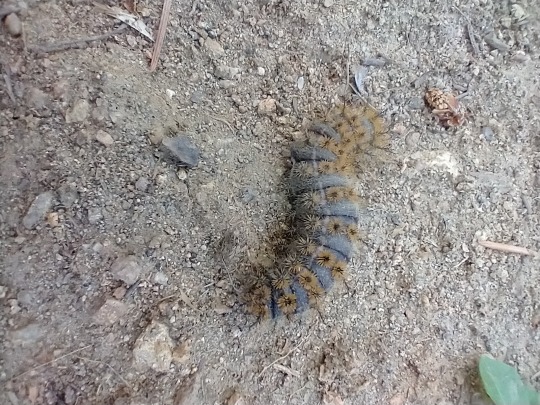
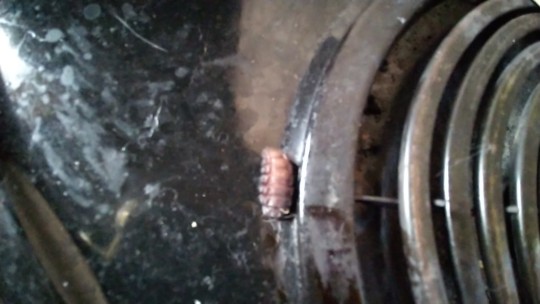

Two shots of each, and an ID would be cool!! The fellow on the stove was deeply unsettling, and...I couldn't tell if he was injured? He either just had a weird end-of-body-segment or had been damaged, but it didn't look like a cut or anything. He was about the size of a big raisin or a small chickpea. The caterpillar I figure the human hand is scale enough!
I know pre-adult forms are hard to nail down so don't worry, that dude was just Weird
Hi! The caterpillar looks like a western sheep moth. Adults are BEAUTIFUL:
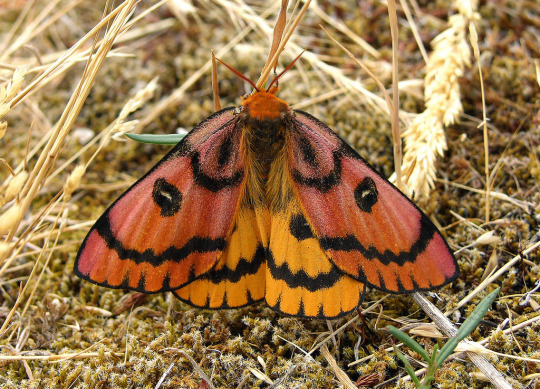
Wow :) Photo by rick_c_west
I’m afraid I’d need a better look at the other larva to tell you what it is. As far as I can tell from those photos, it’s some sort of fly larva or pupa. Was it alive? Had you had any meat or produce near the stove recently? Is it possible you have mice in your house? It reminds me most of a mouse botfly. If you haven’t gotten rid of it I’d be interested to see what it pupates into!
62 notes
·
View notes
Note
i keep wanting to draw anthro maggots but they end up looking like beetle larvae instead- any ideas on how one might stylize a maggot person to make it a little more distinctly A Maggot? it's especially hard to me bc maggots are like THE MOST featureless insect larvae.... which i suppose counts as a defining feature in and of itself- but i dunno. im mostly just curious to hear your approach!!!
Yeah beetle grubs, caterpillars and a lot of other insect larvae have armored heads with complete jaws structures as well as six little legs, plus they often have a defined looking "top" and "bottom" with ridged and wrinkles almost like they got soft armored down their back
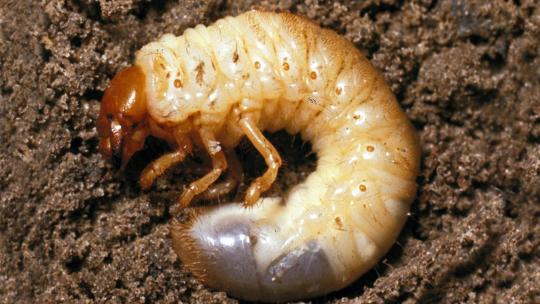
But maggots are weird! They streamlined EVERYTHING down to where they have no legs at all, not even vestigial ones, and their body segments almost evolved towards something like radial symmetry by being the same all the way around!
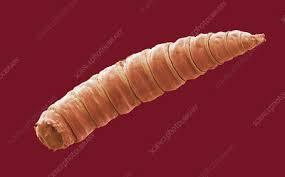
Then there's the fact that they sort of lost most of a "head." Not only is there no exoskeletal cranial case (bug skull) to protect it but there are no jaws and never any eyes; there's just a little hole for drinking liquefied food, a pair of tusk-like hooks for gripping surfaces, and a pair of eye-like knobs that are actually chemosensory (noses)

The weird, tiny walrus-face is totally unique! They don't have any chewing mouthparts because they only need to "drink" the particles of rotting matter they live on, and like adult flies, they help this along by secreting digestive enzymes!
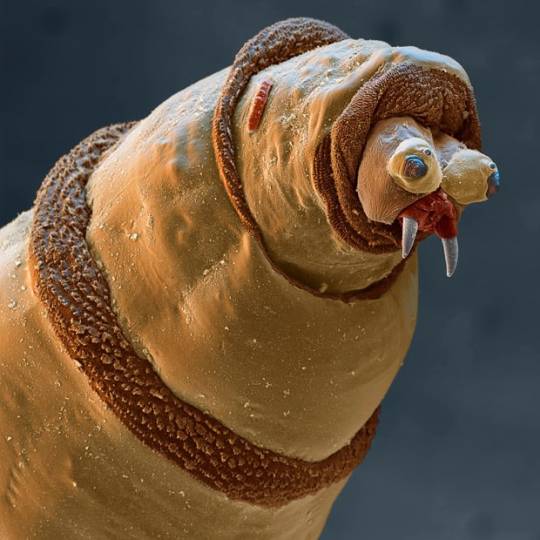
Maggots also have these very distinct, furry looking bands at every segment, which help them grip surfaces like a tire tread or the sole of a shoe. If you compare this photo with the one above you'll also notice how the segments can retract in and out like a telescope!

The last special thing about common maggot anatomy is that they are technically semi-aquatic animals, because maggots evolved to be buried head-first completely in their own food as much as possible and rotten corpses are WET. In order to breathe, maggots have a pair of breathing spiracles on their rear ends, which they try to keep exposed to the air!
There are exceptions to all of this, though; there are species that can be fully aquatic, fully terrestrial, herbivorous, parasitic or predatory, and some ancient fly groups (including mosquitoes!) whose larvae still have fully armored heads and even eyes. Everything above is universal to the maggots you find in rotten stuff though, so what most people think of when they hear the term :) When I designed a hybrid human and blowfly maggot for the Mortasheen setting I deliberately made it look like a doofy cartoon Walrus, and I gave its segments large spines that can be seen in some parasitic maggots, including botflies:

And when I made a maggot character for my webcomic Awful Hospital I designed her like a little spacesuit or a parka (the resemblance to Kenny was an accident)
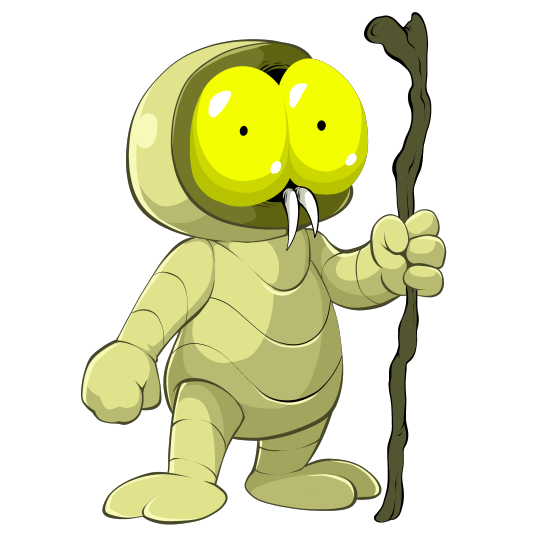
Actually I don't think I ever shared this most recent "main artwork" of Maggie. I don't know what idea inspiration any of this might provide but basically a maggot is a prickly living sock with fangs. Or I guess from a design and engineering perspective, a maggot is a biological drill. The tiny end starts a hole, the rest of the body is just a flaring cone perfectly equipped to keep making the hole deeper.
391 notes
·
View notes
Note
how do u feel about kissing bugs and bot flies? theyyy majorly spook me personally ⚰️ i am a big wasp and hornet lover tho and don't mind centipedes and spiders.
i like them from afar! adult botflies are especially super cute looking... i would not like either of them anywhere near my body lmao. from what i understand botflies aren't actually dangerous unless there's a secondary infection but do hurt a lot and generally just sound unpleasant. in general any kind of parasitic bug that is actively harmful or super unpleasant is something i Do Not Want to be near but can appreciate just as animals. leeches can stay (since they aren't disease vectors & don't like. burrow into your body) but they can't have my blood! i don't have a lot of it!
11 notes
·
View notes
Note
What's the most obscure piece of Greek mythology that you've incorporated into your world? Or, barring that, what gives you the most glee to think of how you've folded it in (but like the kind of gleefulness that comes from thinking up a really good/bad pun)? Thanks for being you!
I was really happy with the fact that I'm basing “Bacchus”on a lot of the more obscure and Orphic text on Dionysus pre Greek influence Roman Mythology on Liber on him rather then make him just The Party God, but I think a lot of that is going to be less obscure now that the game Hades came out and more people are familiar with the name Zagreus (my take on him is...much different tho)
I based Minerva(Athena)’s design on a Fly because the myth of Metis. In some stories Athena was not born from Zeus alone but rather had a mother named Metis that Zeus turned into a fly and devoured to prevent her giving birth to a son. She gives birth to Athena inside Zeus who then emerges from his skull a grown adult fully armed. It made me imagine Minerva being like a botfly of sorts.
I'm basing Gorgons much more on older depictions and descriptions of them then I am on modern takes. Bronze claws/hands, Boar tusks, Wings (yes Debbie has wings but they are like an earwig’s and she keeps them folded up).

The little wing ears is based on Roman mosaics of Medusa which often give her little wings on her head

Also Peneyote is cactus themed because she is a Hesperide, a Nymph of the evening but also “The West”
93 notes
·
View notes
Text
TW: Extremely disgusting anomaly, demoniac themes, innuendo of sex, detailed vermin description and infection, gore/violence, gore drawing
ANM-688-1 Instance:

"Would humanity's destiny be to be consumed by flies? Having their bodies infested and controlled?"
Identification: The Queen of Flies
Responsible Researcher: The Eleven Counselors
ANM #: ANM-688-XK
Class: Pre-Apocalypse 💀 | Partially Contained ➖️
Type: Insectoid, Historical, Parasitic, Multi-Anomalous
Degree of Unhealthiness: 120%
Damage Type: Manipulative, physical, mental, continental
Confinement: ANM-688-XK must be contained in a climate-controlled containment chamber of at least 20 meters by 20 meters in the Deep Dark Chamber. The temperature must be maintained below -20°C (-4°F) to prevent the hatching and proliferation of ANM-688-1. The walls must be reinforced with fly-proof barriers and sealed airtight. Any breaches in containment must be reported immediately, with security protocols enacted to prevent escape.
Personnel entering the containment area must be equipped with full-body hermetic suits and are subject to decontamination procedures both before and after entry. Should any personnel exhibit signs of infestation, they are to be isolated and terminated before further spread occurs. Specimens of ANM-688-1 are only to be studied in labs equipped with the same cold containment, and no experimentation involving ANM-688-Ω is to be conducted without prior Eleven Counselors approval.
Infested individuals (ANM-688-2) found outside containment must be neutralized and incinerated immediately to prevent widespread contamination. No organic material should be kept inside the containment complex, the fly colony should not be fed, in case the populatorious of ANM-688-1 instances exceeds the limit, the flamethrowers installed inside the chamber should be activated.
Description: Scientifically denominated "Necrosarchia sanguina" (Condessa's Flesh Fly). ANM-688-XK is a parasitic phenomenon involving a swarm of carnivorous black flies and larvae (designated ANM-688-1) that infest human hosts, leading to grotesque necrosis, parasitic control, and eventual death. The primary vector of infestation is through contact with ANM-688-1, which rapidly reproduces upon exposure to human skin, entering the host's orifices, open wounds, or pores. Once inside the host body, ANM-688-1 larvae begin feeding on tissue, laying eggs deep within muscles and internal organs.
Victims (classified as ANM-688-2) are conscious throughout the entirety of the infestation process. The first stage involves larvae burrowing under the skin, causing severe pain and visual discomfort as they writhe and tunnel through the flesh. This stage is marked by rapid necrosis, with tissue blackening and peeling away as larvae devour both living and dead cells. Victims remain aware and horrified as they observe their bodies decaying in real-time, with the most visible signs being the collapse of facial features and the putrid smell of rotting flesh.
The second stage of the infestation manifests when ANM-688-1 larvae mature into adult flies inside the body of ANM-688-2, primarily nesting within the mouth, eyes, and other orifices. At this point, the host’s movements become erratic and involuntary, as the nervous system is slowly overridden by parasitic control. Victims describe a visceral sensation of being "puppeteered" by the swarm within them, their limbs moving against their will.
The ANM-688-1 larvae resemble grotesque, swollen versions of typical parasitic larvae, similar in appearance to botfly larvae but with more disturbing features due to their supernatural nature.
The larvae are bloated, segmented, and have a glossy red-brown exterior, often looking engorged with blood or fluids. The texture of the larval body appears fleshy and slightly translucent, with the internal development of parasitic fly offspring visible beneath the skin. The spiracles at the rear end are large and distinct, enabling respiration even when deeply embedded in host tissue. On average, the larvae measure 4-6 cm in length, though they may swell significantly as they feed and mature. Their surface is smooth and almost rubbery, glistening with a natural coating of enzymes that aid in the decomposition of human tissue.
These larvae burrow into the flesh of their hosts, primarily targeting soft tissues such as muscle and fat. They release a combination of necrotizing agents and neurotoxins that break down tissue while keeping the host alive and mobile. The larvae feed continuously, creating large, ulcerated wounds as they grow.
As the larvae feed, they produce offspring within their own bodies, a process visible through their translucent skin. This "internal parasitism" allows them to burst open upon maturation, releasing newly hatched larvae into the host’s body or surrounding environment. This secondary generation is immediately capable of continuing the infestation cycle.
Upon maturing, the larvae of ANM-688-1 undergo pupation within the decaying host tissue before emerging as grotesque adult flies. These flies bear the hallmarks of their parasitic nature, with several physical deformities that set them apart from normal Diptera.
The adult flies are swollen, their abdomens distended as though filled with parasitic offspring at all times. Their bodies appear unnaturally large, especially in the midsection, with their thin legs struggling to support their weight. Adult flies measure between 2.5-4 cm in length, significantly larger than typical flies, with their swollen appearance giving them a bloated, grotesque form.
Some flies are covered in sparse, bristly hair, while others appear entirely bald, with their glossy exoskeletons exposed. In more extreme cases, the exoskeleton appears translucent and fragile, revealing the mass of parasitic larvae gestating within the adult fly. Their eyes are unnaturally large and dark, almost beetle-like, with a dull shine that seems to track movement in a predatory manner. Their proboscis is long, crooked and needle-like, capable of piercing skin with ease to inject eggs directly into hosts.
The adult flies are often visibly filled with larvae, their engorged abdomens ready to burst with their parasitic offspring. In some cases, the adult flies do not survive long after laying eggs, as the pressure of internal parasitism causes their abdomens to split open, releasing hundreds of larvae directly into the environment.
The adult flies are aggressive and exhibit erratic flying patterns. They are drawn to the scent of blood and decaying tissue and prefer warm, damp environments for breeding. Despite their fragile appearance, they are incredibly resilient, with even severely damaged flies continuing to function until they release their offspring.
The psychological effects during these stages are profound. While ANM-688-2 may attempt to communicate, their speech becomes garbled as flies fill their throats, often forcing them to regurgitate larval masses. Hosts eventually lose the ability to vocalize entirely. Despite losing physical autonomy, the victim's mind remains intact, suffering from the horror of being fully aware as their body is reduced to a rotting husk filled with crawling parasites.
Once the larvae reach a critical number, the host is driven to seek out new humans, violently assaulting others in an effort to infest them through saliva, blood, or direct contact with the writhing mass of larvae erupting from their skin. ANM-688-2, in their final moments of control, often express agonizing fear and revulsion, forced to watch as they spread the plague they can neither halt nor control.

ANM-688-Ω: "Condessa Sangramenta"
ANM-688-Ω, also known as "Countess Sangramenta" or, Elizabeth Báthory, is the entity believed to control and command ANM-688-1. Historical records suggest that ANM-688-Ω is the infamous Hungarian countess, Elizabeth Báthory, notorious for her alleged vampiric tendencies and penchant for bathing in the blood of virgins to retain youth. However, recent discoveries point to a far darker truth.
ANM-688-Ω is thought to have made a pact with the demon Beelzebub, commonly known as the Lord of the Flies, granting her dominion over parasitic flies in exchange for her eternal servitude and the requirement to "mate" with him in a grotesque ritual of flesh and pestilence. This pact has resulted in ANM-688-Ω transformation into a near-immortal entity, described by witnesses as a gaunt woman with pallid skin, covered in boils and constantly surrounded by a swarm of ANM-688-1.
ANM-688-Ω commands the flies as extensions of her own body, able to direct infestations from a distance and communicate telepathically with ANM-688-2. Victims report hearing whispers from her voice, urging them to spread her plague, often followed by an overwhelming compulsion to obey. ANM-688-Ω has demonstrated intelligence, cruelty, and a desire to spread her parasitic kingdom across the globe.
Addendum 688-01: Interview with ANM-688-2
Date: ██/██/20██
Subject: ANM-688-2, formerly General August, an MTF unit commander exposed during a failed containment breach.
Interview Log Transcript:
General August: (voice trembling) "Please… help me. They’re everywhere. Under my skin. I feel them chewing, breeding."
Dr. Öctavio: "Describe what you’re experiencing, August. It’s important we understand."
General August: "I can hear her… in my head. Sangramenta—she’s always whispering. Telling me… to give in, to let them take me. I’m fighting, but it’s so hard. My hands—look! Look what they’ve done to me!"
(At this point, General August lifts his shirt, revealing festering boils and wriggling larvae beneath the surface of his skin. His body is covered in open sores, through which ANM-688-1 can be seen crawling.)
Dr. Öctavio: "How much control do you still have?"
General August: (sobbing) "None. I can’t stop them. They move me when I don’t want to move. I tried to leave the chamber, but… they wouldn’t let me. They dragged me back. It’s like I’m a passenger… in my own corpse."
Dr. Öctavio: "Do you believe you can still fight her influence?"
General August: (weakly) "It doesn’t matter. She wants you, all of you. The flies… they’ll spread. We are... her kingdom now."
(General August collapses, flies erupting from his eyes and mouth as his body convulses. Medical personnel are called in, but termination is deemed necessary before the infestation can spread further.)
ANM-688-2 by Öctavio Kalev:

Closing Statement: ANM-688-Ω remains an active threat, with containment proving exceedingly difficult due to her ability to communicate and influence from afar. The continued existence of ANM-688-Ω suggests a larger network of parasitic control than originally suspected. Further research is required to understand the extent of her dominion and prevent an apocalyptic spread of ANM-688-1.
Note: Any interaction or experimentation involving ANM-688-Ω is prohibited without the Eleven Counselors clearance. ANM-688 represents an existential threat should it breach containment. Termination options remain under review, though as of now, no known methods have proven effective in neutralizing ANM-688-Ω.
5 notes
·
View notes
Text
Also, re: "On this basis the insect, to deliver 370 watts, must consume 0.31 grams per sec or 1.5 times his own weight of food each second!"
Adults deer botflies don't feed at all.
Oh look, there's been a Tunneling Teddy Bear (deer botfly) sighting today

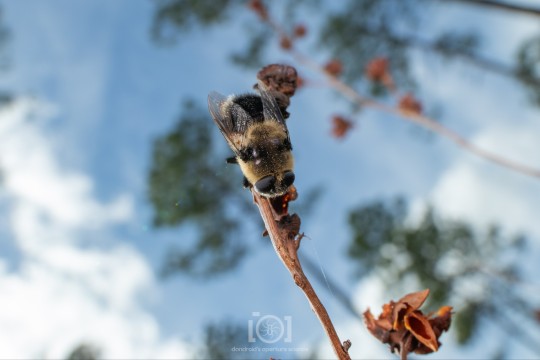
(I swear to Christ I'll be blocking fools for garbage comments about these creatures. I know what they are. Move along if your only thought is disgust)
660 notes
·
View notes